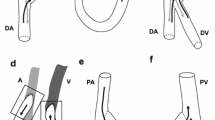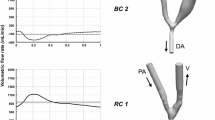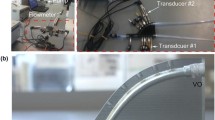Abstract
The flow rate inside arteriovenous fistulas is many times higher than physiological flow and is accompanied by high wall shear stress resulting in low patency rates. A fluid–structure interaction finite element model is developed to analyse the blood flow and vessel mechanics to elucidate the mechanisms that can lead to failure. The simulations are validated against flow measurements obtained from magnetic resonance imaging data.
















Similar content being viewed by others
References
Alastrué V, Garía A, Peña E, Rodríguez JF, Martínez MA, Doblaré M (2010) Numerical framework for patient-specific computational modelling of vascular tissue. Int J Numer Methods Biomed Eng 26(1):35–51
Allon M, Robbin ML (2002) Increasing arteriovenous fistulas in hemodialysis patients: problems and solutions. Kidney Int 62(4):1109–1124
Ash SR, Dhamija R, Zaroura MY, Hentschel DM (2012) The StenTec gauge for measuring static intra-access pressure ratio (PIa ratio) of fistulas and grafts. In: Seminars in dialysis, Blackwell Publishing Ltd., vol 25, pp 474–481
Bangerth W, Hartmann R, Kanschat G (2007) deal. II—a general-purpose object-oriented finite element library. ACM Trans Math Softw 33(4):24
Bank AJ, Kaiser DR, Rajala S, Cheng A (1999) In vivo human brachial artery elastic mechanics effects of smooth muscle relaxation. Circulation 100(1):41–47
Bazilevs Y, Gohean JR, Hughes TJR, Moser RD, Zhang Y (2009) Patient-specific isogeometric fluid–structure interaction analysis of thoracic aortic blood flow due to implantation of the Jarvik 2000 left ventricular assist device. Comput Methods Appl Mech Eng 198(45):3534–3550
Boghosian M, Cassel K, Hammes M, Funaki B, Kim S, Qian X, Wang X, Dhar P, Hines J (2014) Hemodynamics in the cephalic arch of a brachiocephalic fistula. Med Eng Phys 36(7):822–830
Bozzetto M, Ene-Iordache B, Remuzzi A (2016) Transitional flow in the venous side of patient-specific arteriovenous fistulae for hemodialysis. Ann Biomed Eng 44(8):2388–2401
Braack M, Burman E, John V, Lube G (2007) Stabilized finite element methods for the generalized Oseen problem. Comput Methods Appl Mech Eng 196(4):853–866
Braack M, Mucha PB, Zajaczkowski WM (2014) Directional do-nothing condition for the navier-stokes equations. J Comput Math 32(5):507–521
Brooks AN, Hughes TJ (1982) Streamline upwind/Petrov–Galerkin formulations for convection dominated flows with particular emphasis on the incompressible Navier–Stokes equations. Comput Methods Appl Mech Eng 32(1):199–259
Browne LD, OCallaghan S, Hoey DA, Griffin P, McGloughlin TM, Walsh MT (2014) Correlation of hemodynamic parameters to endothelial cell proliferation in an end to side anastomosis. Cardiovasc Eng Technol 5(1):110–118
Carroll GT, McGloughlin TM, Callanan A, Walsh MT (2009) Realistic temporal variations of shear stress modulate mmp-2 and mcp-1 expression in arteriovenous vascular access. Cell Mol Bioeng 2(4):591
Causin P, Gerbeau JF, Nobile F (2005) Added-mass effect in the design of partitioned algorithms for fluid-structure problems. Comput Methods Appl Mech Eng 194(42):4506–4527
Chung J, Hulbert GM (1993) A time integration algorithm for structural dynamics with improved numerical dissipation: the generalized-\(\alpha \) method. J Appl Mech 60(2):371–375
Corpataux JM, Haesler E, Silacci P, Ris HB, Hayoz D (2002) Low-pressure environment and remodelling of the forearm vein in Brescia–Cimino haemodialysis access. Nephrol Dial Transplant 17(6):1057–1062
Cunnane CV, Cunnane EM, Walsh MT (2017) A review of the hemodynamic factors believed to contribute to vascular access dysfunction. Cardiovasc Eng Technol 8(3):1–15
Cunningham KS, Gotlieb AI (2005) The role of shear stress in the pathogenesis of atherosclerosis. Lab Invest 85(1):9–23
de Villiers A, McBride AT, Reddy BD (2017) Fsi fistula. https://doi.org/10.5281/zenodo.437473
Decorato I, Kharboutly Z, Legallais C, Salsac AV (2011) Numerical study of the influence of wall compliance on the haemodynamics in a patient-specific arteriovenous fistula. Comput Methods Biomech Biomed Eng 14(sup1):121–123
Ene-Iordache B, Remuzzi A (2012) Disturbed flow in radial-cephalic arteriovenous fistulae for haemodialysis: low and oscillating shear stress locates the sites of stenosis. Nephrol Dial Transplant 27(1):358–368
Fry DL (1968) Acute vascular endothelial changes associated with increased blood velocity gradients. Circ Res 22(2):165–197
Gasser TC, Ogden RW, Holzapfel GA (2006) Hyperelastic modelling of arterial layers with distributed collagen fibre orientations. J R Soc Interface 3(6):15–35
Gatehouse PD, Keegan J, Crowe LA, Masood S, Mohiaddin RH, Kreitner KF, Firmin DN (2005) Applications of phase-contrast flow and velocity imaging in cardiovascular MRI. Eur Radiol 15(10):2172–2184
Gee M, Förster C, Wall W (2010) A computational strategy for prestressing patient-specific biomechanical problems under finite deformation. Int J Numer Methods Biomed Eng 26(1):52–72
Hammes M, Boghosian M, Cassel K, Watson S, Funaki B, Doshi T, Akherat SJM, Hines J, Coe F (2016) Increased inlet blood flow velocity predicts low wall shear stress in the cephalic arch of patients with brachiocephalic fistula access. PLoS ONE 11(4):e0152873
Haruguchi H, Teraoka S (2003) Intimal hyperplasia and hemodynamic factors in arterial bypass and arteriovenous grafts: a review. J Artif Organs 6(4):227–235
Heil M (2004) An efficient solver for the fully coupled solution of large-displacement fluid–structure interaction problems. Comput Methods Appl Mech Eng 193(1):1–23
Holzapfel GA (2002) Nonlinear solid mechanics: a continuum approach for engineering science. Meccanica 37(4):489–490
Holzapfel GA, Gasser TC, Ogden RW (2000) A new constitutive framework for arterial wall mechanics and a comparative study of material models. J Elast Phys Sci Solids 61(1–3):1–48
Hsu MC, Bazilevs Y (2011) Blood vessel tissue prestress modeling for vascular fluid-structure interaction simulation. Finite Elem Anal Des 47(6):593–599
Huberts W, Canneyt KV, Segers P, Eloot S, Tordoir JHM, Verdonck P, van de Vosse FN, Bosboom EMH (2012) Experimental validation of a pulse wave propagation model for predicting hemodynamics after vascular access surgery. J Biomech 45(9):1684–1691
Hughes TJR, Liu WK, Zimmermann TK (1981) Lagrangian–Eulerian finite element formulation for incompressible viscous flows. Comput Methods Appl Mech Eng 29(3):329–349
Iori F, Grechy L, Corbett R, Gedroyc W, Duncan N, Caro C, Vincent P (2015) The effect of in-plane arterial curvature on blood flow and oxygen transport in arterio-venous fistulae. Phys Fluids 27(3):031903
Kaiser DR, Mullen K, Bank AJ (2001) Brachial artery elastic mechanics in patients with heart failure. Hypertension 38(6):1440–1445
Kang S, Choi H, Yoo JY (2012) Investigation of fluid-structure interactions using a velocity-linked P2/P1 finite element method and the generalized-\(\alpha \) method. Int J Numer Meth Eng 90(12):1529–1548
Kenner T (1989) The measurement of blood density and its meaning. Basic Res Cardiol 84(2):111–124
Kharboutly Z, Deplano V, Bertrand E, Legallais C (2010) Numerical and experimental study of blood flow through a patient-specific arteriovenous fistula used for hemodialysis. Med Eng Phys 32(2):111–118
Kroll MH, Hellums JD, McIntire L, Schafer A, Moake J (1996) Platelets and shear stress. Blood 88(5):1525–1541
Lee SW, Smith DS, Loth F, Fischer PF, Bassiouny HS (2007) Importance of flow division on transition to turbulence within an arteriovenous graft. J Biomech 40(5):981–992
Malik J, Tuka V, Tesar V (2009) Local hemodynamics of the vascular access for hemodialysis. Kidney Blood Press Res 32(1):59–66
Manini S, Passera K, Huberts W, Botti L, Antiga L, Remuzzi A (2014) Computational model for simulation of vascular adaptation following vascular access surgery in haemodialysis patients. Comput Methods Biomech Biomed Eng 17(12):1358–1367
Markl M, Kilner PJ, Ebbers T (2011) Comprehensive 4D velocity mapping of the heart and great vessels by cardiovascular magnetic resonance. J Cardiovasc Magn Reson 13(7):10–1186
McGah PM, Leotta DF, Beach KW, Aliseda A (2014) Effects of wall distensibility in hemodynamic simulations of an arteriovenous fistula. Biomech Model Mechanobiol 13(3):679–695
Meyerson SL, Skelly CL, Curi MA, Shakur UM, Vosicky JE, Glagov S, Christen T, Gabbiani G, Schwartz LB (2001) The effects of extremely low shear stress on cellular proliferation and neointimal thickening in the failing bypass graft. J Vasc Surg 34(1):90–97
Moghadam ME, Bazilevs Y, Hsia TY, Vignon-Clementel IE, Marsden AL et al (2011) A comparison of outlet boundary treatments for prevention of backflow divergence with relevance to blood flow simulations. Comput Mech 48(3):277–291
Ngoepe MN, Reddy BD, Kahn D, Meyer C, Zilla P, Franz T (2011) A numerical tool for the coupled mechanical assessment of anastomoses of PTFE arterio-venous access grafts. Cardiovasc Eng Technol 2(3):160–172
Niemann AK, Udesen J, Thrysoe S, Nygaard JV, Frund ET, Petersen SE, Hasenkam JM (2010) Can sites prone to flow induced vascular complications in a-v fistulas be assessed using computational fluid dynamics? J Biomech 43(10):2002–2009
Pelteret JP, McBride A (2016) The step—44 tutorial program. http://www.dealii.org/8.4.1/doxygen/deal.II/step_44.html
Roy S, Silacci P, Stergiopulos N (2005) Biomechanical proprieties of decellularized porcine common carotid arteries. Am J Physiol Heart Circ Physiol 289(4):H1567–H1576
Ryou HS, Kim S, Ro K (2013) A numerical study of the effect of catheter angle on the blood flow characteristics in a graft during hemodialysis. Korea-Aust Rheol J 25(1):19–27
Safar ME, Blacher J, Pannier B, Guerin AP, Marchais SJ, Guyonvarch PM, London GM (2002) Central pulse pressure and mortality in end-stage renal disease. Hypertension 39(3):735–738
Shirazian S, Rios-Rojas L, Drakakis J, Dikkala S, Dutka P, Duey M, Cho DJ, Fishbane S (2012) The effect of hemodialysis ultrafiltration on changes in whole blood viscosity. Hemodial Int 16(3):342–350
Van Canneyt K, Pourchez T, Eloot S, Guillame C, Bonnet A, Segers P, Verdonck P (2010) Hemodynamic impact of anastomosis size and angle in side-to-end arteriovenous fistulae: a computer analysis. J Vasc Access 11(1):52–58
Vignon-Clementel IE, Figueroa CA, Jansen KE, Taylor CA (2006) Outflow boundary conditions for three-dimensional finite element modeling of blood flow and pressure in arteries. Comput Methods Appl Mech Eng 195(29):3776–3796
Vignon-Clementel IE, Figueroa CA, Jansen KE, Taylor CA (2010) Outflow boundary conditions for 3D simulations of non-periodic blood flow and pressure fields in deformable arteries. Comput Methods Biomech Biomed Eng 13(5):625–640
Wick T (2013) Solving monolithic fluid-structure interaction problems in Arbitrary Lagrangian Eulerian coordinates with the deal.II library. Arch Numer Softw 1(1):1–19
Wick T (2015) Modeling, discretization, optimization, and simulation of fluid-structure interaction. Lecture notes, http://www.sciencedirect.com/science/article/pii/B9781856176354000145
Zhuang YJ, Singh T, Zarins C, Masuda H (1998) Sequential increases and decreases in blood flow stimulates progressive intimal thickening. Eur J Vasc Endovasc Surg 16(4):301–310
Acknowledgements
The work by AMdV, ATMcB and BDR has been supported by the National Research Foundation of South Africa through the South African Research Chair in Computational Mechanics. This support is acknowledged with thanks. The authors acknowledge and thank Delawir Kahn, Jennifer Downs, Ernesta Meintjies and Stephen Jermy for their contribution, which include project management, and capturing and processing the MRI scans.
Author information
Authors and Affiliations
Corresponding author
Ethics declarations
Conflict of interest
The authors declare that they have no conflict of interest.
Appendices
Appendix 1
1.1 Linearized Navier–Stokes equations
Three-directional derivatives of the momentum balance equation of the fluid in the reference configuration are required. The directional derivative with respect to a incremental velocity field \(\varDelta {\mathbf {v}}\) is given by
Next the directional derivative resulting from a incremental displacement field in the mesh motion \(\varDelta \mathbf {u}\) is
with
and
Lastly the directional derivative of the momentum equation with respect to an incremental change in the pressure field \(\varDelta p\) is shown:
Directional derivatives for the incompressibility constraint are found with respect to the incremental changes in the velocity and displacement fields. Note that the directional derivative with respect to pressure is zero in the fluid domain. This results in zeroes on the diagonal of the Jacobian matrix on the fluid domain. The directional derivative for the incompressibility constraint with respect to \(\varDelta v\) is given by
and with respect to \(\varDelta u\) by
1.2 Linearized mesh motion equations
The mesh motion equation is only a function of \(\mathbf {u}\) and there is only one nonzero directional derivative:
1.3 Linearized structure equations
The linearized equations associated with the structure are as follows. The directional derivatives for (25)\(_1\) are
The directional derivatives for (25)\(_2\) are
The directional derivatives for (25)\(_3\) are
The tangent \(\mathscr {A}={\partial \mathbf {P}}/{\partial \mathbf {F}}\) can be split additively into an isotropic part and a part associated with anisotropic deformations,
The calculations for the tangent make use of the chain rule. Before the tangent is computed, partial derivatives of (21) and the Cauchy–Green tensor are shown:
and
Using (57–58), the tangent associated with the ground matrix is calculated as
The tangent associated with the fibres can be calculated using (23), (24) and (58) as:
with
Appendix 2
1.1 Linearization of backflow stabilization
The linearization of the boundary condition requires a precomputed global vector which contains the linearization of the flow terms
\(D_{\varDelta {\mathbf {v}}} Q_{\mathrm{out}}\) is the directional derivative of \(Q_{\mathrm{out}}\) at a given velocity \({\mathbf {v}}\) in the direction of the incremental velocity field \(\varDelta {\mathbf {v}}\). The linearization of the second term in (30) using the generalized resistive boundary condition is given by
For the particular case of a purely resistive boundary, such as present in (30), \(f(Q_{\mathrm{out}})=R_RQ_{\mathrm{out}}\) and the derivative to be used in (64) is \( f'(Q_{\mathrm{out}}))=R_R\).
Appendix 3
1.1 Weak form of Windkessel model
To prescribe the relationship between the flow and pressure, \(f(Q_{\mathrm{out}})\) is given by
where C is the capacitance, \(R_R\) the resistance at the outlet, \(\tau =R_{\mathrm{d}}C\) the relaxation parameter, and \(R_d\) the resistance downstream. The velocity evaluated at some time s during the timestep \(t^l\) to \(t^{l+1}\) is given by
Here \(\triangle t\) is the size of the timestep. After time discretization \(f(Q_{\mathrm{out}}^{n+1-\alpha _{\mathrm{f}}})\) can be evaluated by
where \(h^{n+1}\) is given by
Finally, after integrating over time,
Rights and permissions
About this article
Cite this article
de Villiers, A.M., McBride, A.T., Reddy, B.D. et al. A validated patient-specific FSI model for vascular access in haemodialysis. Biomech Model Mechanobiol 17, 479–497 (2018). https://doi.org/10.1007/s10237-017-0973-8
Received:
Accepted:
Published:
Issue Date:
DOI: https://doi.org/10.1007/s10237-017-0973-8




